An Earthquake Early Warning Method Based on Bayesian Inference
Abstract
1. Introduction
2. Earthquake Data Selection and Preprocessing
- We selected data from earthquakes within 10 km of the focal depth and 200 km from the epicenter.
- The short–term average to long–term average (STA/LTA) and Akaike information criteria (AIC) were combined to automatically detect the arrival of the P- wave and manually correct it.
- The acceleration record was corrected at the baseline, and the acceleration records were integrated to obtain the velocity and displacement records. Following this, 0.075 Hz Butterworth high-pass filtering was performed to eliminate the low-frequency drift caused by integration.
- Earthquake records should meet certain Signal to Noise Ratio(SNR) requirements during the calculations. In this paper, velocity amplitudes greater than 0.05 cm/s within 3 s after P-wave triggering were selected as the SNR criteria. Noise reduction of the selected records was also performed to reduce the high-frequency interference of the acceleration records. A total of 145 earthquakes were screened out. Figure 1 presents the distribution of the magnitude, epicenter distance, and earthquake frequency of the dataset.
3. Traditional Calculation Method for Earthquake Magnitude and PGV
3.1. Magnitude Calculation using Average Period τc
3.2. Calculation of PGV using Displacement Amplitude Pd
4. A Dual-Parameter Earthquake Warning Model Based on Bayesian Inference
4.1. Prediction of Earthquake Magnitude and PGV Based on Bayesian Estimation
4.2. Prediction and Simulation of Magnitude Based on Bayesian Inference
4.3. Predictive Simulation of PGV Based on Bayesian Inference
4.4. Earthquake Judgment Model Based on Dual-Parameter Prediction
5. Comparative Testing and Analysis
6. Discussion and Conclusions
Author Contributions
Funding
Institutional Review Board Statement
Informed Consent Statement
Data Availability Statement
Acknowledgments
Conflicts of Interest
References
- Guo, K.; Wen, R.Z.; Peng, K.Y. Effectiveness evaluation and social benefits analyses on earthquake early warning system. Acta Seismol. Sin. 2016, 38, 146–154. [Google Scholar]
- Zhang, C.J.; Chen, H.Z.; Cai, J.A.; Hou, Y.Y.; Xu, H.H.; Li, W.D. Discussion on some issues of earthquake early warning engineering. J. Eng. Stud. 2014, 6, 344–370. [Google Scholar] [CrossRef]
- Zhang, H.C. Research on Key Technologies of Earthquake Early Warning System; Institute of Engineering Mechanics, China Earthquake Adminiistration: Harbin, China, 2013; pp. 1–190. [Google Scholar]
- Feng, J.W. Real-Time Estimation of the Ground Motion Field of Large Earthquakes; Institute of Engineering Mechanics, China Earthquake Adminiistration: Harbin, China, 2019; pp. 1–164. [Google Scholar]
- Kanamori, H. Real-time seismology and earthquake damage mitigation. Ann. Rev. Earth Planet Sci. 2005, 33, 195–214. [Google Scholar] [CrossRef]
- Zhao, C. Study on the Characteristics of P-Wave to Estimate Magnitude and PGA, PGV in the Field of Earthquake Early Warning; Southwest Jiaotong University: Chengdu, China, 2013; pp. 33–61. [Google Scholar]
- Iervolino, I.; Convertito, V.; Giorgio, M.; Manfredi, G.; Zollo, A. Real-time risk analysis for hybrid earthquake early warning systems. J. Earthq. Eng. 2006, 10, 867–875. [Google Scholar] [CrossRef][Green Version]
- Wu, J.Q. Research on Progressive Ground Motion Intensity Warning Based on Bayes Principle and Characteristic Parameters of the P-Wave; Beijing Jiaotong University: Beijing, China, 2016; pp. 37–70. [Google Scholar]
- Zhou, Y.X.; Zhang, S.L.; Guo, K.; Zhang, Y. High speed train control strategy in earthquake early warning system. Technol. Earthq. Disaster Prev. 2015, 10, 116–125. [Google Scholar]
- Li, S.J.; Lü, Y.J.; Liu, J.W. Research on b-value statistical sample size in Gutenberg Richter law. Technol. Earthq. Disaster Prev. 2018, 13, 636–645. [Google Scholar]
- Zollo, A.; Amoroso, O.; Lancieri, M.; Wu, Y.M.; Kanamori, H. A threshold-based earthquake early warning using dense accelerometer networks. Geophys. J. Int. 2010, 183, 963–974. [Google Scholar] [CrossRef]
- Hao, M.X.; Zhou, Y.X.; Zhang, J.Z.; Zhang, K.; Yin, Z.J. Application of τc method in the early warning magnitude calculation in Inner Mongolia region. Earthouake Res. China 2020, 36, 136–145. [Google Scholar]
- Peng, C.Y.; Yang, J.S.; Zheng, Y.; Zhu, X.Y.; Xu, Z.Q.; Chen, Y. New τc regression relationship derived from all P wave time windows for rapid magnitude estimation. Geophys. Res. Lett. 2017, 44, 1724–1731. [Google Scholar]
- Long, C.H.; Lai, M.; Yu, H.; Li, D.H. Study on the correction between effective peak ground acceleration and seismic intensity. Earthq. Res. Sichuan 2011, 2, 26–31. [Google Scholar]
- Fang, J.Z.; Zhang, Y.; Wang, K.; Dong, Y. The Research on Application of Site Correction of Ground Motion in Rapid Reporting of Seismic Intensity. South China J. Seismol. 2020, 40, 17–26. [Google Scholar]
- Ma, Q.; Li, S.L.; Li, S.Y.; Tao, D.W. On the correlation of ground motion parameters with seismic intensity. Earthq. Eng. Eng. Dyn. 2014, 34, 83–92. [Google Scholar]
- Song, J.D.; Jiao, C.C.; Li, S.Y.; Hou, B.R. Prediction method of first-level earthquake warning for high speed railway based on two-parameter threshold of seismic P-wave. China Railw. Sci. 2018, 39, 138–144. [Google Scholar]
- Wang, Y.W.; Li, X.J.; Cao, Z.Z.; Lan, J.Y.; Liu, J. Continuous estimation magnitude for earthquake early warning based on Kik-net borehole bedrock strong motions. Earthq. Eng. Eng. Dyn. 2020, 40, 42–52. [Google Scholar]
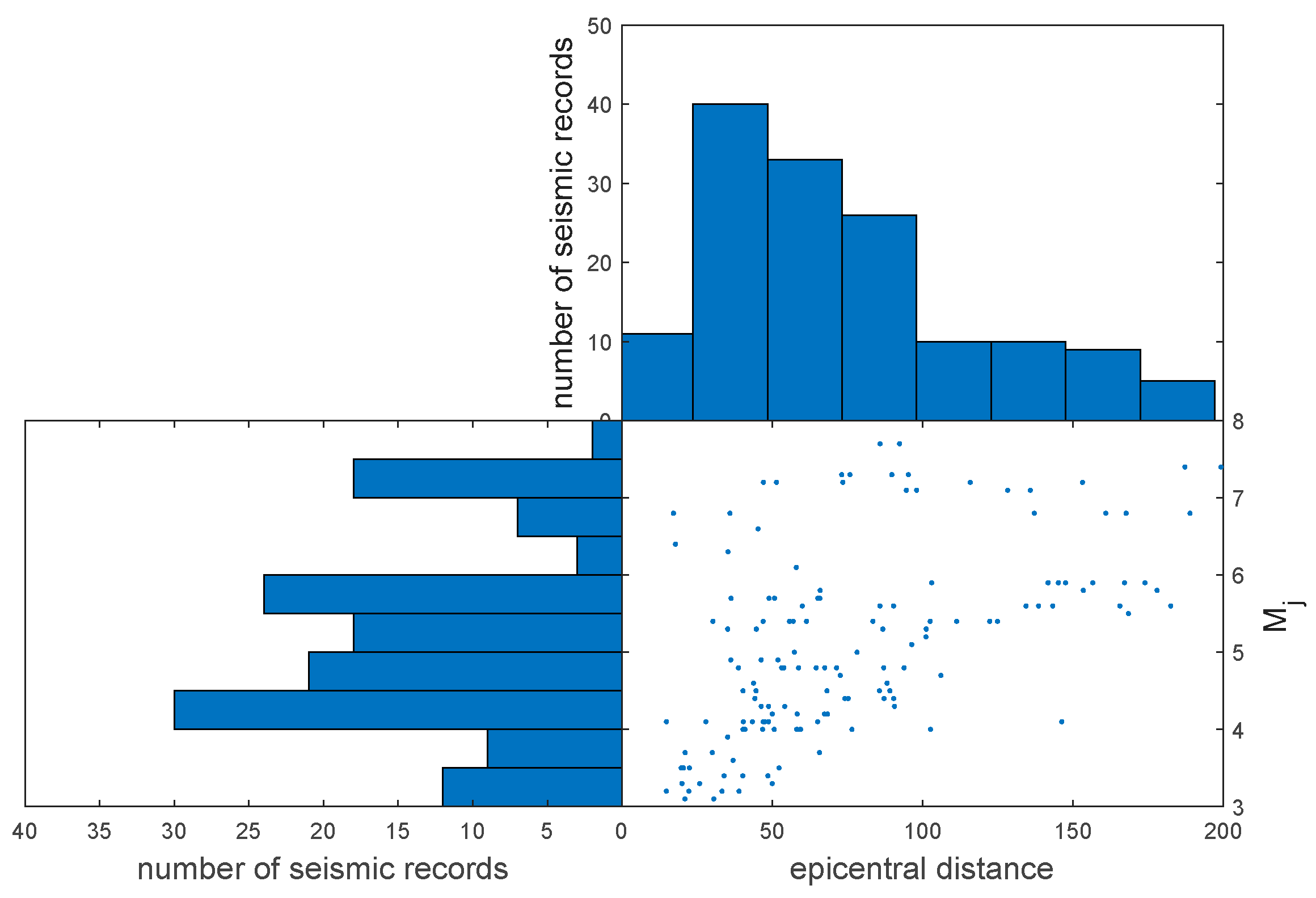
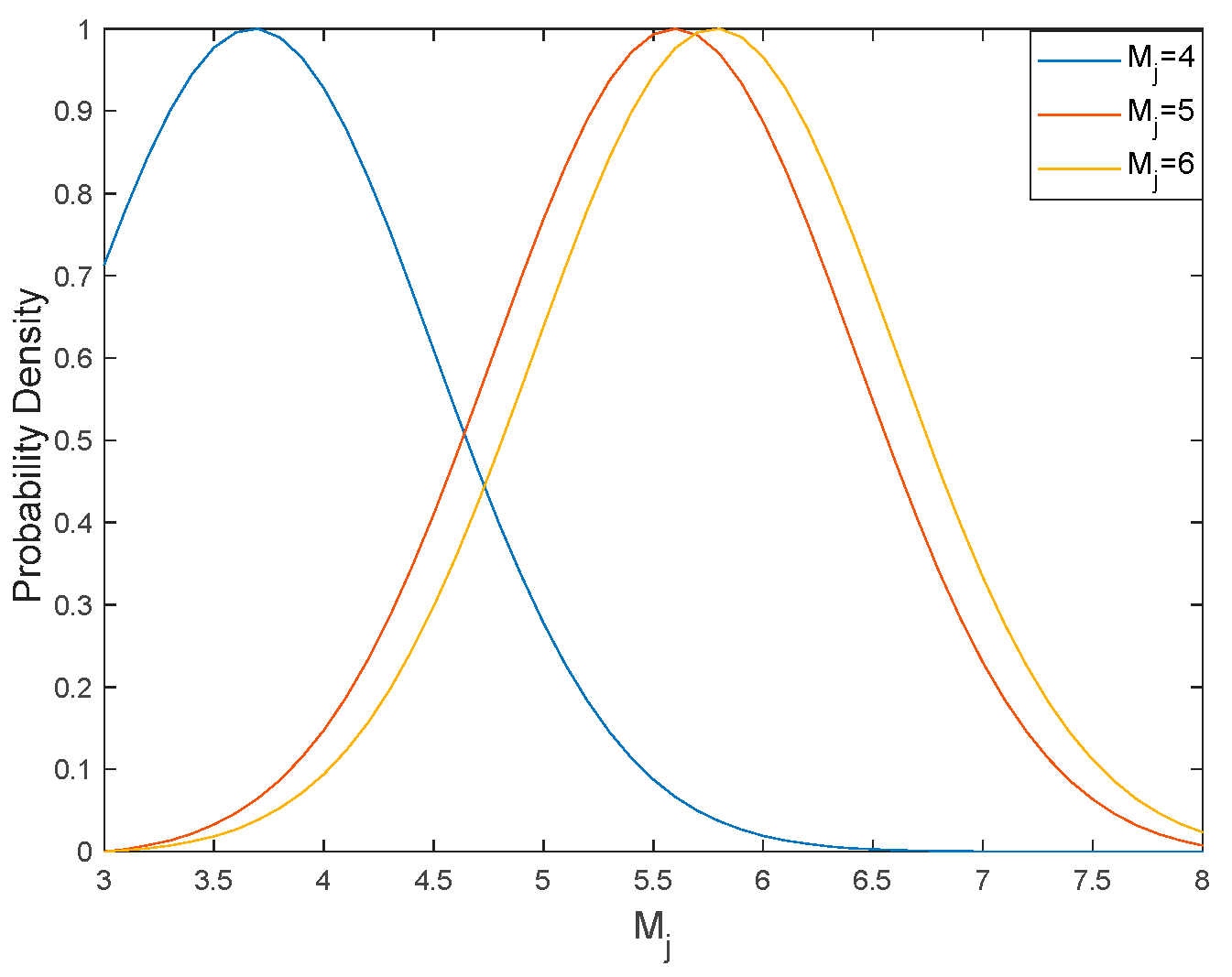
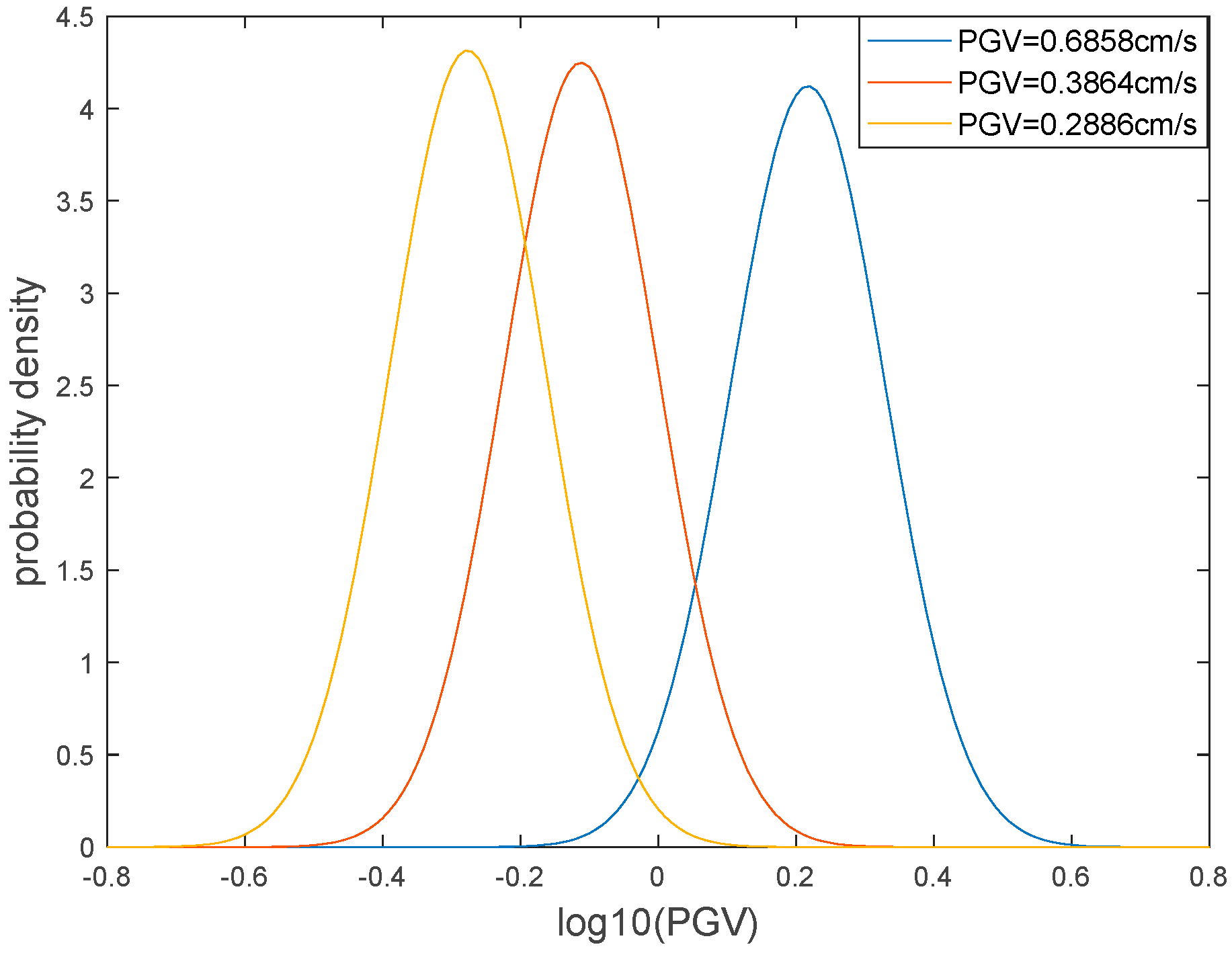
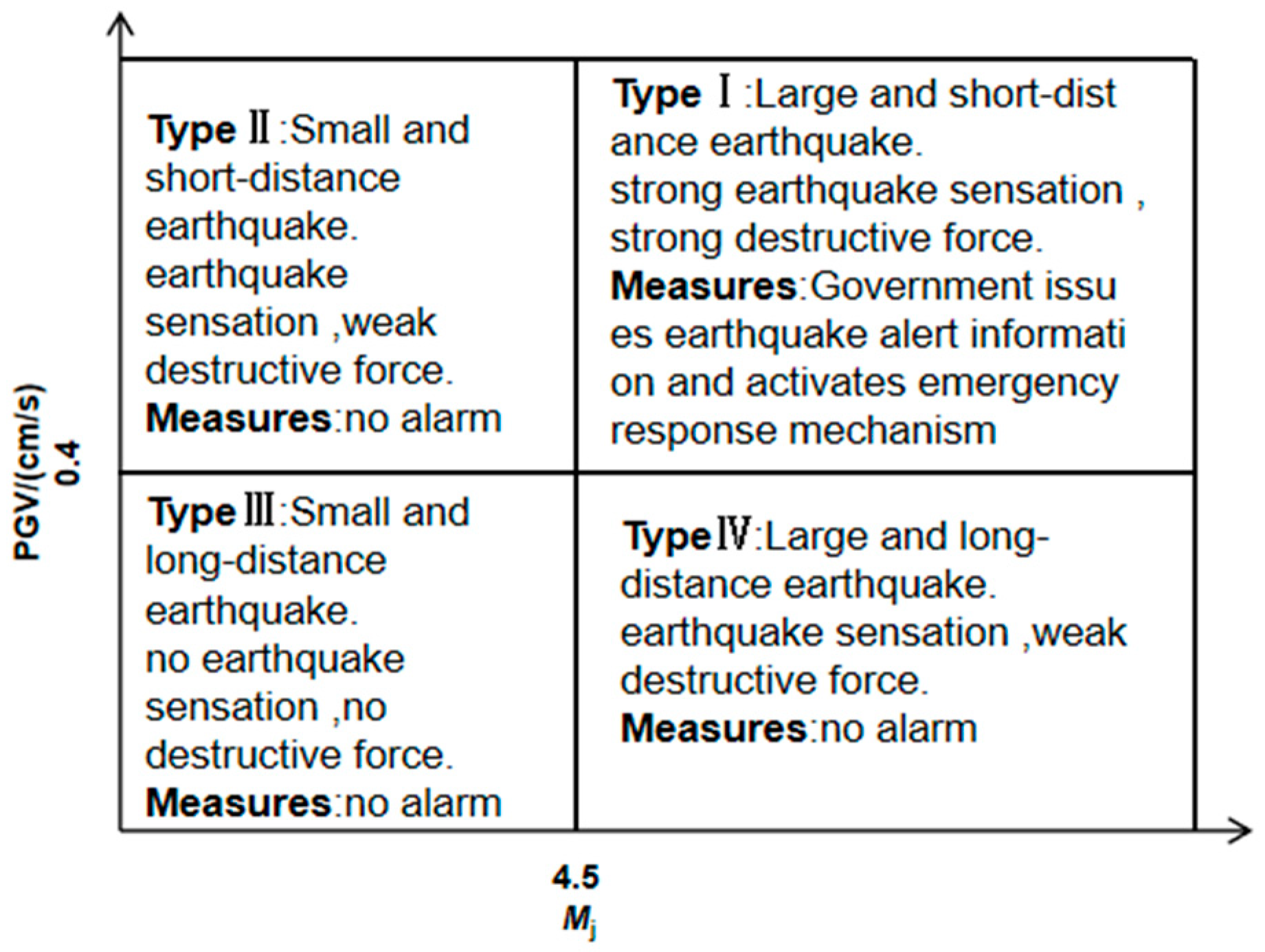

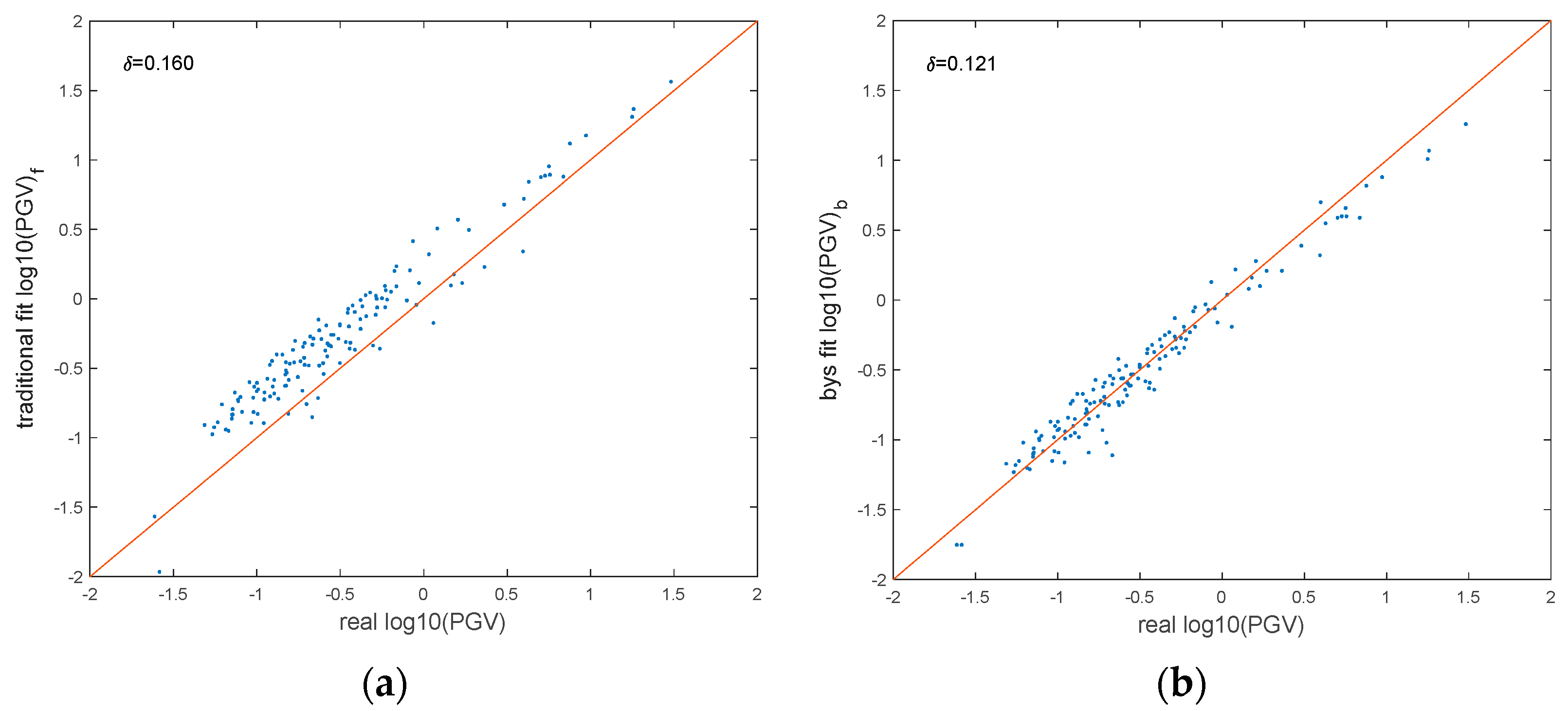

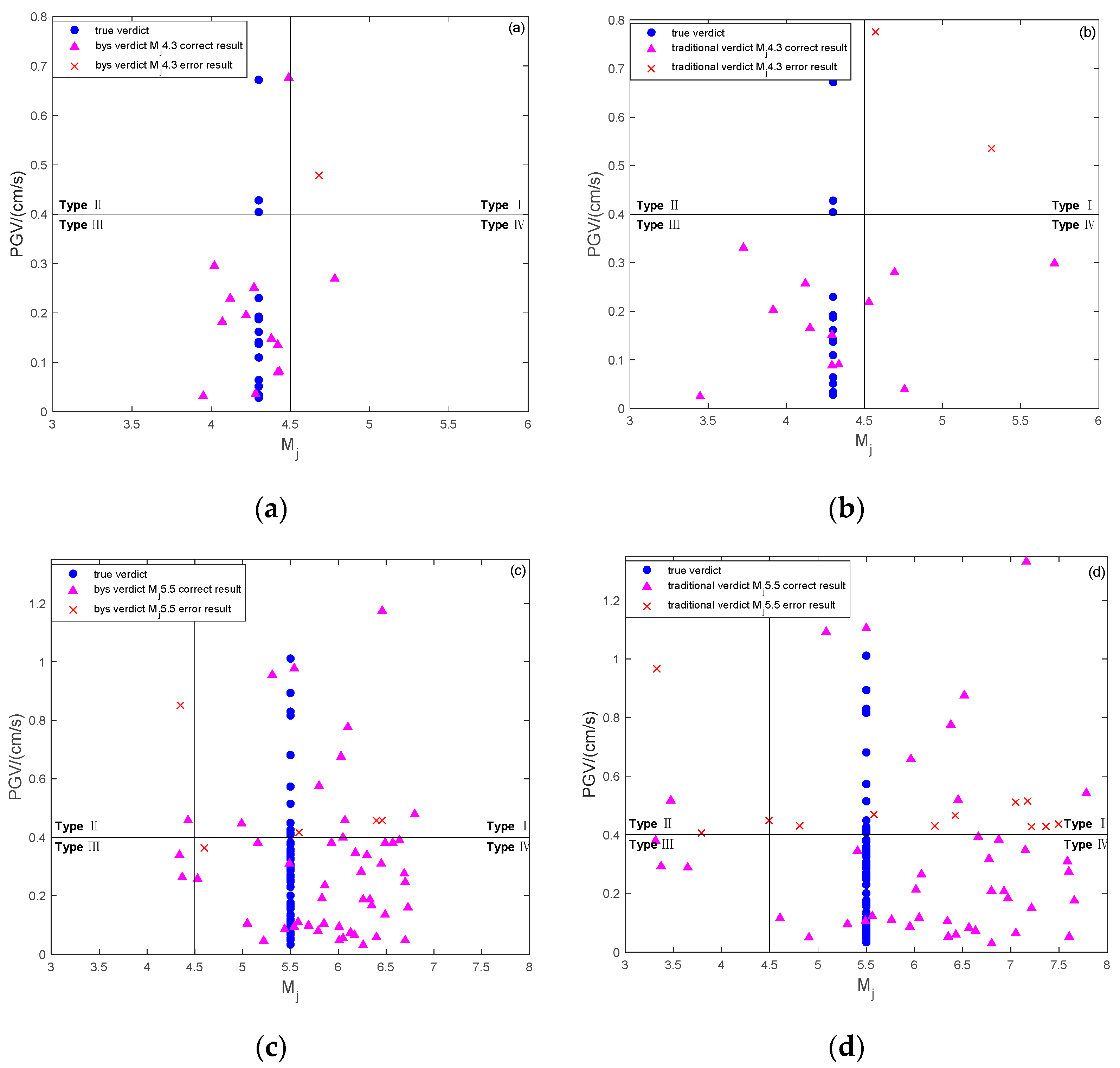
| Missed Alarm | False Alarm | ||||
|---|---|---|---|---|---|
| Number of Missed Alarms | Missed Alarm Rate | Number of False Alarms | False Alarm Rate | ||
| Bayesian prediction method | 2 | 2.94% | 4 | 5.88% | |
| Traditional fitting method | 3 | 4.41% | 11 | 16.18% | |
Publisher’s Note: MDPI stays neutral with regard to jurisdictional claims in published maps and institutional affiliations. |
© 2022 by the authors. Licensee MDPI, Basel, Switzerland. This article is an open access article distributed under the terms and conditions of the Creative Commons Attribution (CC BY) license (https://creativecommons.org/licenses/by/4.0/).
Share and Cite
Yang, J.; He, F.; Li, Z.; Zhang, Y. An Earthquake Early Warning Method Based on Bayesian Inference. Appl. Sci. 2022, 12, 12849. https://doi.org/10.3390/app122412849
Yang J, He F, Li Z, Zhang Y. An Earthquake Early Warning Method Based on Bayesian Inference. Applied Sciences. 2022; 12(24):12849. https://doi.org/10.3390/app122412849
Chicago/Turabian StyleYang, Jingsong, Fulin He, Zhitao Li, and Yinzhe Zhang. 2022. "An Earthquake Early Warning Method Based on Bayesian Inference" Applied Sciences 12, no. 24: 12849. https://doi.org/10.3390/app122412849
APA StyleYang, J., He, F., Li, Z., & Zhang, Y. (2022). An Earthquake Early Warning Method Based on Bayesian Inference. Applied Sciences, 12(24), 12849. https://doi.org/10.3390/app122412849






